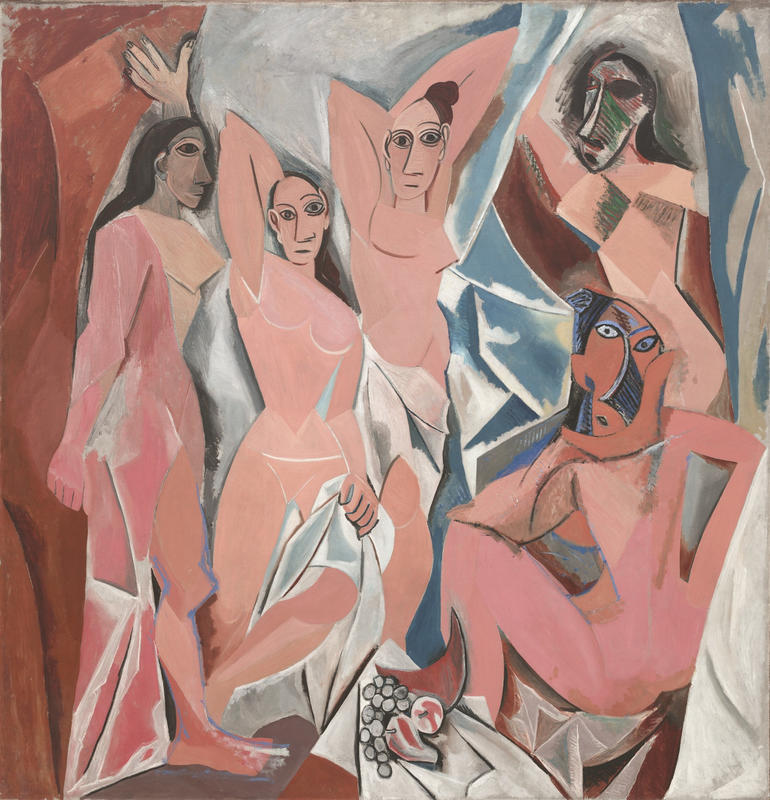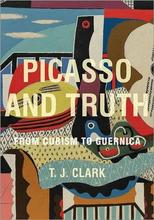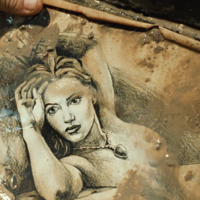More about Les Demoiselles d'Avignon
- All
- Info
- Shop

Contributor
If this wasn’t a WTF moment in art history then I don’t know what was.
Sick of playing by the rules, Picasso just went for it in Les Demoiselles d’Avignon (The Young Ladies of Avignon), and quite literally changed the face of painting as we knew it. Folks say this painting hails the advent of modern art, which is probably why it is one of the most visited painting at the MoMA.
These odd looking ladies stare out at us from a brothel window in a very “whatchu lookin’ at?” kind of way. The frank, direct gaze of Manet’s Olympia and how she makes the viewer uncomfortable may have inspired Picasso, but these prostitutes make Olympia look run of the mill. The art world was shocked by Picasso’s total dismissal of those little things taught in art school like perspective, anatomy, scale, yadda-yadda-yadda. But for real, what is going on in this painting? Is that woman on the right peeking out of curtains behind everyone else or on the same visual plane? Are the two figures in the center standing up or lying down? And I can’t even start with the squatting figure that looks like she's doing her best The Excorcist impression.
Before this painting, Picasso was stuck in his Rose period and playing it quite safe. And then suddenly – there was this. It was like shards of glass had exploded all over the canvas and left these jagged ladies behind. Originally, in the sketches, there was a man holding a book in the painting too, but he was left out of the final composition. And a good thing, too. Because girl power is going strong here. Even though the ladies look like they’re posing in the display case of a shop window, they seem completely unapologetic. They appear unaware of the fact that their faces are nothing like the ones you’d see on earlier nudes. They’re just not pretty. In fact, Picasso drew inspiration from Iberian and African masks he’d seen at an exhibition at the Louvre, something that is pretty obvious when you look at both the chicks on the right. Other inspirations: Matisse, Gauguin, El Greco, and Cezanne.
One of the curators from the MoMA talks about how Picasso was afraid of contracting syphilis from these working girls, whose faces might be showing some symptoms of the STD. And that apprehension may be reflected in the uneasiness that the viewer feels when these women stare back. Because, let’s not forget, the very first viewer was Picasso and it's his anxiety that we’re indirectly feeling. It also tells us that Picasso liked to party with hookers, but that shouldn't surprise anyone.
Like most famous artworks, everyone obviously hated this painting when they first saw it. His buddies Braque and Matisse thought it might be some kind of terrible joke, but were intrigued by it nonetheless. The painting was originally titled The Brothel of Avignon but was changed by the curator of the exhibition in which it first raised the publics’ eyebrows. It was bought for the close to nothing price of $24,000 by MoMA in 1937. They had to pawn a Degas to raise the money for this, but I’m guessing they got their money’s worth.
Featured Content
Here is what Wikipedia says about Les Demoiselles d'Avignon
Les Demoiselles d'Avignon (The Young Ladies of Avignon, originally titled The Brothel of Avignon) is a large oil painting created in 1907 by the Spanish artist Pablo Picasso. Part of the permanent collection of the Museum of Modern Art in New York, it portrays five nude female prostitutes in a brothel on Carrer d'Avinyó, a street in Barcelona, Spain. The figures are confrontational and not conventionally feminine, being rendered with angular and disjointed body shapes, some to a menacing degree. The far left figure exhibits facial features and dress of Egyptian or southern Asian style. The two adjacent figures are in an Iberian style of Picasso's Spain, while the two on the right have African mask-like features. Picasso said the ethnic primitivism evoked in these masks moved him to "liberate an utterly original artistic style of compelling, even savage force" leading him to add a shamanistic aspect to his project.
Drawing from tribal primitivism while eschewing central dictates of Renaissance perspective and verisimilitude for a compressed picture plane using a Baroque composition while employing Velazquez's confrontational approach seen in Las Meninas, Picasso sought to take the lead of the avant-garde from Henri Matisse. John Richardson said Demoiselles made Picasso the most pivotal artist in Western painting since Giotto and laid a path forward for Picasso and Georges Braque to follow in their joint development of cubism, the effects of which on modern art were profound and unsurpassed in the 20th century.
Les Demoiselles was revolutionary, controversial and led to widespread anger and disagreement, even amongst the painter's closest associates and friends. Henri Matisse considered the work something of a bad joke yet indirectly reacted to it in his 1908 Bathers with a Turtle. Georges Braque too initially disliked the painting yet studied the work in great detail. His subsequent friendship and collaboration with Picasso led to the cubist revolution. Its resemblance to Cézanne's The Bathers, Paul Gauguin's statue Oviri and El Greco's Opening of the Fifth Seal has been widely discussed by later critics.
At the time of its first exhibition in 1916, the painting was deemed immoral. Painted in Picasso's studio in the Bateau-Lavoir in Montmartre, Paris, it was seen publicly for the first time at the Salon d'Antin in July 1916, at an exhibition organized by the poet André Salmon. It was at this exhibition that Salmon, who had previously titled the painting in 1912 Le bordel philosophique, renamed it to its current, less scandalous title, Les Demoiselles d'Avignon, instead of the title originally chosen by Picasso, Le Bordel d'Avignon. Picasso, who always referred to it as mon bordel ("my brothel"), or Le Bordel d'Avignon, never liked Salmon's title and would have instead preferred the bowdlerization Las chicas de Avignon ("The Girls of Avignon").
Check out the full Wikipedia article about Les Demoiselles d'Avignon




















I'm still floored by how much is conveyed in this restrained piece.